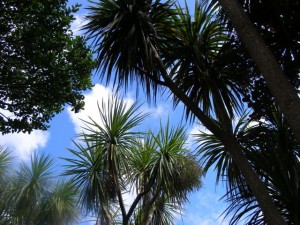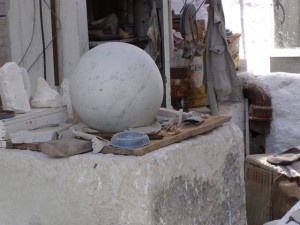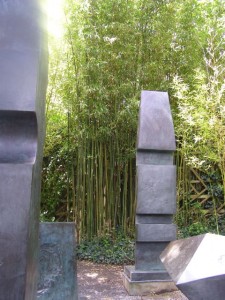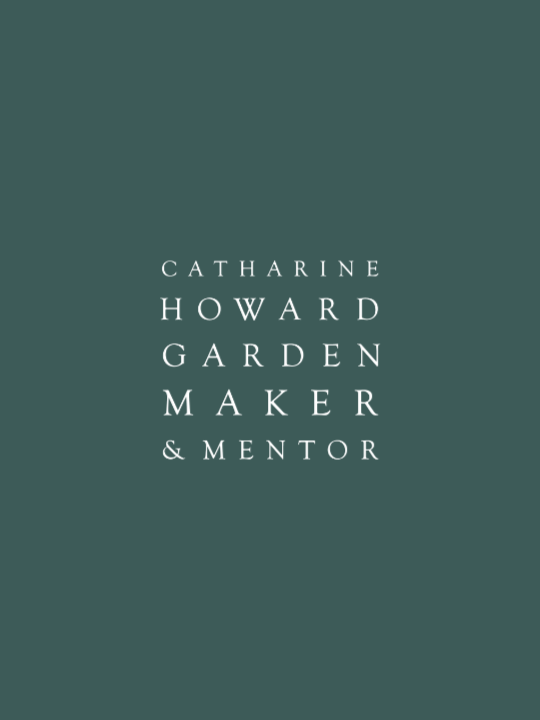[caption id="attachment_466" align="alignleft" width="300" caption="sky in St Ives"]

[/caption]
The hill down to St Ives is thronged with genteel boarding houses, net-curtained and jostling for business with inviting signs outside. Small front gardens are brimful of pots of geraniums and petunias with benches positioned to catch every sliver of sunshine. Gull shriek is loud and sparkling reflections bounce off the sea. Carefree holiday makers abound. In the cemetery, tumbling down towards the shorefront with stone crosses in rows, a family have taken over some hummocks to enjoy the seaview and their picnic. Below, Tate St Ives dominates the town white and bright and looking out into the bay. A late summer exhibition for the Beach Boys left a memory of canned music and desconstructed designer wet suits – beautiful space but not much within it.
The studio of the late Barbara Hepworth is tucked away just off a tea shoppe, ice cream cobbled way and with its famous garden is an oasis away from tourist bustle and road rage over parking spaces. The house is emptied of its furnishings and has her life in biography through photographs downstairs and upstairs a range of sculptures in stone and wood – so sensuous that you want to reach out
[caption id="attachment_468" align="alignleft" width="300" caption="studio of Barbara Hepworth"]

[/caption]
and caress them. Stepping outside the garden has been left as something of a shrine – Hepworth worked here for 24 years and all her major works were created in this small space. The workshop is flanked by stone ready to be carved, dusty overalls hang on pegs inside and pieces of marble waiting on the production line. Aged 74 she died tragically in a fire on night of 1975. Her tools are ready for her to step out of the little white summer house in the garden and get on with it.
The garden space is intimate and introverted – tower of St Ives church apart - the view is not allowed into the garden. Jungle planting brings the eye in to complement some very large works, mainly executed in metal. So what can be learnt from visiting an outdoor space filled with priceless works of art? The first, is the knowledge that Hepworth made this garden not be a public sculpture park, but for her own enjoyment. The plants have been selected with great care to be a foil to her works. Shrubs, trees, bamboos, perennials and palms have been chosen for foliage effects. Copy this when you think up a planting scheme: Look beyond the brief moment of flowering colour of any plant and give marks for silhouettes in winter, shadows cast, movement and noise in the breeze. Consider the size of leaves and contrast with other plants chosen.

A starting point for plant selection will be to decide on a style for the garden and then select the plants that will fit in: Trewyn Studio is seaside jungle and the mood is set by large cordylines which have their lower branches removed to show up their trunks and turn them into mini palm trees. They dominate the skyline and send down sharp shadows.
Then there are a range of other plants which earn their place as ‘architectural’: Fatsia japonica is one – a brilliant plant for a shadey garden with its handsized and shaped shiney leaves which have the added plus of being evergreen. Then there is tender, cut leaved Melianthus and whorl-leaved Euphorbia characias which throws up acid green flower spikes in late spring. Phormiums with their large evergreen sword bladed leaves appear round the garden and resonate with the sculptures. ‘Conversation with Magic Stones’ was the last placing of works by Hepworth in her garden. This gaunt collection of bronzes is surrounded in by clumps of a bamboo - Phyllostachys ‘Henonis’ which emphasise the height of the assembled pieces and makes a perfect stage setting – with their close straight shiney stems and their bend and rustle in the breeze.
Take a visit to Trewyn at a leisurely pace: sit and absorb the tranquillity of this small space and think about placing even one sculpture in your own garden.
 [/caption]
The hill down to St Ives is thronged with genteel boarding houses, net-curtained and jostling for business with inviting signs outside. Small front gardens are brimful of pots of geraniums and petunias with benches positioned to catch every sliver of sunshine. Gull shriek is loud and sparkling reflections bounce off the sea. Carefree holiday makers abound. In the cemetery, tumbling down towards the shorefront with stone crosses in rows, a family have taken over some hummocks to enjoy the seaview and their picnic. Below, Tate St Ives dominates the town white and bright and looking out into the bay. A late summer exhibition for the Beach Boys left a memory of canned music and desconstructed designer wet suits – beautiful space but not much within it.
The studio of the late Barbara Hepworth is tucked away just off a tea shoppe, ice cream cobbled way and with its famous garden is an oasis away from tourist bustle and road rage over parking spaces. The house is emptied of its furnishings and has her life in biography through photographs downstairs and upstairs a range of sculptures in stone and wood – so sensuous that you want to reach out
[caption id="attachment_468" align="alignleft" width="300" caption="studio of Barbara Hepworth"]
[/caption]
The hill down to St Ives is thronged with genteel boarding houses, net-curtained and jostling for business with inviting signs outside. Small front gardens are brimful of pots of geraniums and petunias with benches positioned to catch every sliver of sunshine. Gull shriek is loud and sparkling reflections bounce off the sea. Carefree holiday makers abound. In the cemetery, tumbling down towards the shorefront with stone crosses in rows, a family have taken over some hummocks to enjoy the seaview and their picnic. Below, Tate St Ives dominates the town white and bright and looking out into the bay. A late summer exhibition for the Beach Boys left a memory of canned music and desconstructed designer wet suits – beautiful space but not much within it.
The studio of the late Barbara Hepworth is tucked away just off a tea shoppe, ice cream cobbled way and with its famous garden is an oasis away from tourist bustle and road rage over parking spaces. The house is emptied of its furnishings and has her life in biography through photographs downstairs and upstairs a range of sculptures in stone and wood – so sensuous that you want to reach out
[caption id="attachment_468" align="alignleft" width="300" caption="studio of Barbara Hepworth"] [/caption]
and caress them. Stepping outside the garden has been left as something of a shrine – Hepworth worked here for 24 years and all her major works were created in this small space. The workshop is flanked by stone ready to be carved, dusty overalls hang on pegs inside and pieces of marble waiting on the production line. Aged 74 she died tragically in a fire on night of 1975. Her tools are ready for her to step out of the little white summer house in the garden and get on with it.
The garden space is intimate and introverted – tower of St Ives church apart - the view is not allowed into the garden. Jungle planting brings the eye in to complement some very large works, mainly executed in metal. So what can be learnt from visiting an outdoor space filled with priceless works of art? The first, is the knowledge that Hepworth made this garden not be a public sculpture park, but for her own enjoyment. The plants have been selected with great care to be a foil to her works. Shrubs, trees, bamboos, perennials and palms have been chosen for foliage effects. Copy this when you think up a planting scheme: Look beyond the brief moment of flowering colour of any plant and give marks for silhouettes in winter, shadows cast, movement and noise in the breeze. Consider the size of leaves and contrast with other plants chosen.
[/caption]
and caress them. Stepping outside the garden has been left as something of a shrine – Hepworth worked here for 24 years and all her major works were created in this small space. The workshop is flanked by stone ready to be carved, dusty overalls hang on pegs inside and pieces of marble waiting on the production line. Aged 74 she died tragically in a fire on night of 1975. Her tools are ready for her to step out of the little white summer house in the garden and get on with it.
The garden space is intimate and introverted – tower of St Ives church apart - the view is not allowed into the garden. Jungle planting brings the eye in to complement some very large works, mainly executed in metal. So what can be learnt from visiting an outdoor space filled with priceless works of art? The first, is the knowledge that Hepworth made this garden not be a public sculpture park, but for her own enjoyment. The plants have been selected with great care to be a foil to her works. Shrubs, trees, bamboos, perennials and palms have been chosen for foliage effects. Copy this when you think up a planting scheme: Look beyond the brief moment of flowering colour of any plant and give marks for silhouettes in winter, shadows cast, movement and noise in the breeze. Consider the size of leaves and contrast with other plants chosen.
 A starting point for plant selection will be to decide on a style for the garden and then select the plants that will fit in: Trewyn Studio is seaside jungle and the mood is set by large cordylines which have their lower branches removed to show up their trunks and turn them into mini palm trees. They dominate the skyline and send down sharp shadows.
Then there are a range of other plants which earn their place as ‘architectural’: Fatsia japonica is one – a brilliant plant for a shadey garden with its handsized and shaped shiney leaves which have the added plus of being evergreen. Then there is tender, cut leaved Melianthus and whorl-leaved Euphorbia characias which throws up acid green flower spikes in late spring. Phormiums with their large evergreen sword bladed leaves appear round the garden and resonate with the sculptures. ‘Conversation with Magic Stones’ was the last placing of works by Hepworth in her garden. This gaunt collection of bronzes is surrounded in by clumps of a bamboo - Phyllostachys ‘Henonis’ which emphasise the height of the assembled pieces and makes a perfect stage setting – with their close straight shiney stems and their bend and rustle in the breeze.
Take a visit to Trewyn at a leisurely pace: sit and absorb the tranquillity of this small space and think about placing even one sculpture in your own garden.
A starting point for plant selection will be to decide on a style for the garden and then select the plants that will fit in: Trewyn Studio is seaside jungle and the mood is set by large cordylines which have their lower branches removed to show up their trunks and turn them into mini palm trees. They dominate the skyline and send down sharp shadows.
Then there are a range of other plants which earn their place as ‘architectural’: Fatsia japonica is one – a brilliant plant for a shadey garden with its handsized and shaped shiney leaves which have the added plus of being evergreen. Then there is tender, cut leaved Melianthus and whorl-leaved Euphorbia characias which throws up acid green flower spikes in late spring. Phormiums with their large evergreen sword bladed leaves appear round the garden and resonate with the sculptures. ‘Conversation with Magic Stones’ was the last placing of works by Hepworth in her garden. This gaunt collection of bronzes is surrounded in by clumps of a bamboo - Phyllostachys ‘Henonis’ which emphasise the height of the assembled pieces and makes a perfect stage setting – with their close straight shiney stems and their bend and rustle in the breeze.
Take a visit to Trewyn at a leisurely pace: sit and absorb the tranquillity of this small space and think about placing even one sculpture in your own garden. 